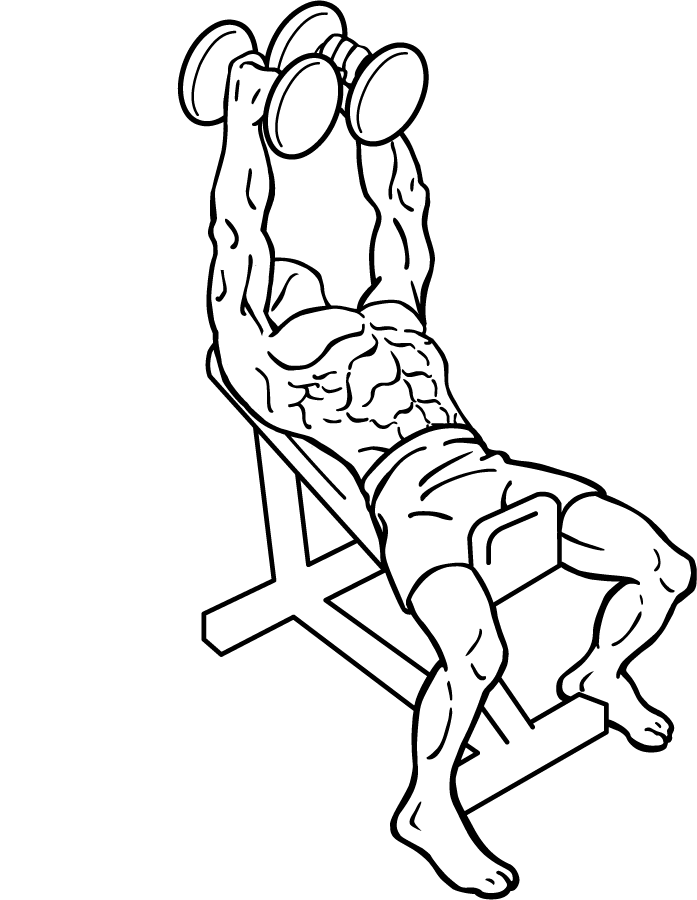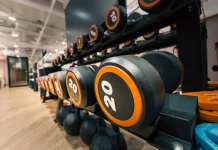Last Updated on September 30, 2014
Incline Dumbbell Flyes are a classic chest exercise designed to build and sculpt the upper pectoral muscles. Known for their effectiveness in creating definition and strength, incline dumbbell flyes are a staple for anyone serious about developing a well-rounded chest. In this comprehensive guide, we’ll explore the benefits, proper technique, common mistakes, variations, and expert tips to get the most out of this powerful movement.
What are Incline Dumbbell Flyes?
Incline Dumbbell Flyes involve lying on an incline bench and performing a controlled fly motion with dumbbells. This exercise primarily targets the upper chest (pectoralis major), while also engaging the anterior deltoids and stabilizer muscles. The movement allows for a deep stretch and contraction of the chest muscles, contributing to muscle growth and improved chest shape.
Muscles Targeted:
- Pectoralis Major (Upper Chest): The primary muscle group engaged, emphasizing the upper portion of the chest.
- Anterior Deltoids: The front shoulder muscles play a supporting role during the movement.
- Stabilizer Muscles: Smaller muscles in the shoulders and arms that help maintain balance and control.
Benefits of Incline Dumbbell Flyes
- Chest Sculpting and Definition: The fly motion stretches the chest muscles, allowing for maximum contraction and development, helping sculpt a fuller and more defined upper chest.
- Improved Range of Motion: Unlike other chest exercises, dumbbell flyes promote a greater range of motion, which is crucial for building muscle flexibility and strength.
- Injury Prevention: Performing this exercise with controlled motion and proper form strengthens the muscles supporting the shoulder joint, reducing the risk of injury in other pressing movements.
- Versatility: Whether you’re a beginner or an advanced lifter, incline dumbbell flyes can be adjusted for weight and intensity, making it suitable for all fitness levels.
How to Perform Incline Dumbbell Flyes Properly
Step-by-Step Guide:
- Set Up the Bench:
- Adjust an incline bench to a 30-45 degree angle. A higher angle shifts more focus onto the shoulders, while a lower angle targets the upper chest more effectively.
- Position Yourself Correctly:
- Lie back on the bench with your feet firmly planted on the ground. Ensure your hips, back, and head are fully in contact with the bench to provide stability.
- Grip the Dumbbells:
- Hold a dumbbell in each hand with your palms facing each other. Extend your arms above your chest with a slight bend in your elbows—this position is your starting point.
- Perform the Fly Motion:
- Keeping the slight bend in your elbows, slowly lower the dumbbells out to your sides in an arc-like motion until you feel a stretch in your chest. Make sure to control the descent and avoid dropping the weights.
- Return to the Starting Position:
- Using your chest muscles, bring the dumbbells back up in the same arc-like motion until they meet above your chest. Pause for a moment, squeeze the chest muscles, and repeat for the desired number of repetitions.
- Repetition Guidelines:
- Aim for 3–4 sets of 8–12 reps to build muscle strength and definition.
Common Mistakes to Avoid
Even though incline dumbbell flyes are relatively straightforward, it’s easy to make mistakes that can compromise the exercise’s effectiveness or increase the risk of injury:
- Using Too Much Weight:
- It’s tempting to go heavy, but using excessive weight can compromise form and lead to injury, especially in the shoulders. Start with a manageable weight and prioritize controlled movement.
- Allowing the Back to Arch:
- Your back and hips should remain in contact with the bench throughout the exercise. Arching your back reduces chest engagement and places strain on the lower back. Engage your core to maintain proper alignment.
- Locking the Elbows:
- Fully extending and locking your elbows can strain your elbow joints. Keep a slight bend to protect your joints and maintain tension in your chest.
- Not Controlling the Movement:
- Rushing through reps or dropping the dumbbells can lead to injury and limit muscle activation. Focus on a slow, controlled descent and ascent for maximum benefit.
- Setting the Bench at an Incorrect Angle:
- If the bench angle is too high, the focus shifts more to the shoulders rather than the chest. Make sure the bench is set between 30 and 45 degrees for optimal chest engagement.
Variations of the Incline Dumbbell Flyes
Incorporating variations into your routine can target different areas of the chest and challenge your muscles in new ways:
- Single-Arm Incline Dumbbell Flyes:
- Perform the exercise with one arm at a time, which enhances the mind-muscle connection and engages the core for added stability.
- Incline Flyes with Resistance Bands:
- Using resistance bands instead of dumbbells provides constant tension throughout the range of motion, increasing muscle activation and enhancing muscle growth.
- Cable Incline Flyes:
- Performing the flyes using a cable machine allows for a more controlled motion and provides continuous tension, which can help build muscle endurance and strength.
- Incline Flyes on Stability Ball:
- Lying on a stability ball instead of a bench challenges your core muscles while performing the flyes, adding a functional fitness element to the exercise.
- Incline Dumbbell Fly with Twist:
- For an added challenge, twist the dumbbells as you bring them up, turning your palms to face your body at the top of the motion. This variation engages the chest muscles differently and adds an extra squeeze at the top.
Tips for Maximizing Your Incline Dumbbell Flyes
- Warm Up Your Chest and Shoulders:
- Before performing the flyes, warm up with light dynamic stretches and mobility exercises for your chest and shoulders. This reduces the risk of strain and prepares your muscles for the workload.
- Engage Your Core:
- Keeping your core tight during the movement helps stabilize your body and prevents arching your lower back. Focus on keeping your abs engaged throughout the entire set.
- Focus on the Stretch and Contraction:
- The effectiveness of the fly motion comes from fully stretching the chest at the bottom and squeezing at the top. Avoid rushing and concentrate on feeling the stretch and contraction with each rep.
- Use a Spotter for Heavy Sets:
- When lifting heavier weights, especially if you’re increasing intensity, having a spotter can ensure you maintain good form and provide assistance when needed.
- Progressive Overload:
- To build muscle, gradually increase the weight, reps, or sets over time. Progressive overload is crucial for continual muscle growth and strength development.
Incline Dumbbell Flyes vs. Other Chest Exercises
Understanding how incline dumbbell flyes compare to other exercises can help you structure your workout for balanced chest development:
- Flat Dumbbell Flyes: This variation focuses more on the middle chest. Incorporating both flat and incline flyes ensures complete chest development and symmetry.
- Incline Chest Press: While the chest press emphasizes strength and power, incline flyes focus on stretching and shaping the chest, offering a complementary approach to building chest mass and definition.
- Pec Deck Machine: This machine mimics the motion of the fly but provides more support and stability. It’s a useful option for beginners or those recovering from shoulder injuries.
By combining these exercises, you can create a comprehensive chest workout that targets all areas of the muscle group.
The Science Behind Incline Dumbbell Flyes
The incline position targets the upper chest by placing the muscle fibers under tension in a way that the flat bench fly does not. Research indicates that altering the angle of chest exercises activates different fibers within the pectoralis major, leading to a more defined and balanced chest appearance. Additionally, the fly motion stretches the muscle, which can increase muscle elasticity and growth when performed with proper technique.
Incline Dumbbell Flyes for Beginners vs. Advanced Lifters
Beginners:
- Start with lighter weights to learn the motion. Focus on mastering the form before increasing the weight. Using the incline bench provides support, allowing beginners to feel stable and build confidence in their movement patterns.
Advanced Lifters:
- Increase the weight gradually, ensuring you still control the movement. Advanced lifters can also try variations like the single-arm fly or using resistance bands to intensify the workout and keep challenging their muscles.
Safety Considerations
- Shoulder Mobility:
- If you have shoulder issues, proceed cautiously with dumbbell flyes, as the motion can be demanding on the shoulder joint. Perform mobility exercises and consider alternative movements like the pec deck if discomfort persists.
- Avoid Overstretching:
- Going too deep in the fly can strain the chest and shoulder muscles. Keep the motion controlled and maintain a slight bend in your elbows to protect your joints.
- Progress Slowly:
- Always start with a weight you can comfortably handle and only increase it when you’re confident with your form. Prioritize muscle activation over lifting heavier weights to prevent injury.
Integrating Incline Dumbbell Flyes into Your Routine
To get the most out of incline dumbbell flyes, it’s important to structure your workouts properly. Here’s how you can effectively integrate them into your chest day:
- Warm-Up:
- Begin with light dynamic stretches and mobility work targeting the chest, shoulders, and arms. Include exercises like shoulder rotations, push-ups, and arm circles to increase blood flow and prepare the muscles.
- Start with Compound Movements:
- Begin your chest workout with heavier compound movements like the incline bench press or flat bench press to build strength and mass. These exercises engage multiple muscle groups and allow you to lift heavier weights.
- Transition to Incline Dumbbell Flyes:
- After your heavy compound lifts, transition to incline dumbbell flyes to focus on muscle isolation and definition. This will fully stretch and contract your chest muscles, enhancing growth and sculpting.
- Finish with Isolation Exercises:
- Wrap up your chest workout with additional isolation exercises like cable flyes or chest dips to target specific areas and fully exhaust the chest muscles.
- Incorporate Progressive Overload:
- As you become more comfortable with the movement, increase the weight or reps gradually. Keep track of your progress, and aim to challenge your muscles consistently for optimal growth.
Sample Incline Dumbbell Flyes Workout
For those looking to incorporate incline dumbbell flyes into their routine, here’s a sample workout focusing on upper chest development:
- Warm-Up:
- Dynamic stretches (5 minutes)
- Light pec flyes (2 sets of 12 reps with light weights)
- Incline Bench Press:
- 3 sets of 8–12 reps (start with a manageable weight)
- Incline Dumbbell Flyes:
- 3 sets of 10–12 reps (focus on form and controlled movement)
- Cable Flyes:
- 3 sets of 12–15 reps (use a moderate weight and squeeze at the top)
- Decline Push-Ups:
- 2 sets to failure (ensure full range of motion)
- Cool Down and Stretch:
- Static chest and shoulder stretches (5–10 minutes)
Nutrition and Recovery: Keys to Building Your Chest
While incline dumbbell flyes are an excellent exercise, chest growth isn’t just about the workout itself. Proper nutrition and recovery play a vital role in muscle development:
- Protein Intake:
- To support muscle repair and growth, consume a diet rich in high-quality protein sources such as chicken, fish, lean beef, eggs, and plant-based proteins like lentils and chickpeas. Aim for at least 1.6–2.2 grams of protein per kilogram of body weight daily.
- Balanced Diet:
- Incorporate a mix of complex carbohydrates (brown rice, quinoa, oats) and healthy fats (avocados, nuts, olive oil) to fuel your workouts and recovery.
- Hydration:
- Staying hydrated is crucial for muscle function and recovery. Aim for at least 8 glasses of water daily, and increase intake around workouts to maintain optimal performance.
- Rest and Recovery:
- Allow your chest muscles time to recover by spacing out your chest workouts. Incorporate rest days and engage in light cardio or mobility work to promote recovery. Sleep is equally important—aim for 7–9 hours per night to give your muscles the recovery time they need.
Final Thoughts
Incline Dumbbell Flyes are an essential part of any upper chest workout routine, providing a unique stretch and contraction that promotes muscle growth and definition. By executing the exercise with proper form, avoiding common mistakes, and incorporating progressive overload, you can maximize the effectiveness of this movement. Remember, the key to sculpting a strong chest lies in a balanced approach—combining a variety of exercises, proper nutrition, and adequate recovery.
Whether you’re a beginner learning the fundamentals or an advanced lifter aiming for that perfectly sculpted upper chest, incline dumbbell flyes are a versatile and effective tool in your arsenal. Keep challenging yourself, stay consistent, and watch your upper chest grow stronger and more defined with each workout.rcise.








